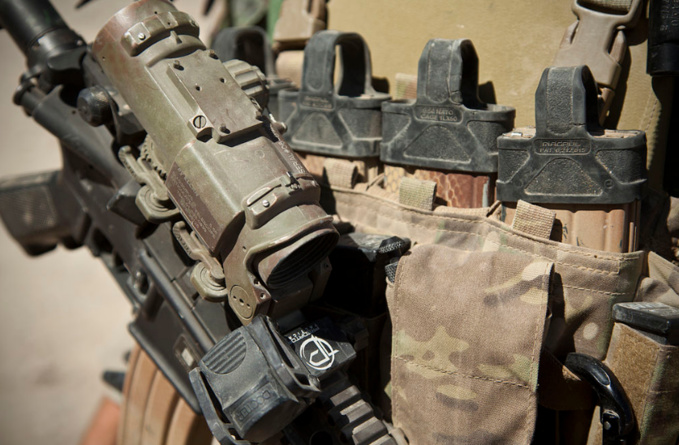According to the IHS study, the volume of world arms market got 10% higher than that in 2014, and amounted to $ 65 billion. Reason for this jump, according to Englewood company's assessment, was a sharp increase in purchases from Saudi Arabia’s side. Demand for weapons has also increased in most of the Middle East and Southeast Asia countries.
According to IHS Global Defence Trade Report, last year, the kingdom stocked up with F-15 fighter jets and Apache helicopters, as well as purchased high-precision weapons, unmanned aerial vehicles and surveillance equipment.
At the end of 2015, Riyadh has been ranked first in the volume of arms imports in the world. In general, volume of arms imports worldwide increased by 50% last year - to $ 9.3 billion.
India and Australia occupy second and third places in terms of weapons purchased, according to the IHS. The fourth place, the study says, took Egypt, which spent almost $ 2.3 billion in 2015.
The IHS believes that oil-exporting countries will be forced to reduce purchase of weapons in the next 3 years due to volatile oil prices. "The countries will spend less on weapons and more on operations as they try to influence events in the region", - the report says. According to the IHS forecast, Russia, the world's second arms exporter after the United States, will increase trade with Iran. After easing Western sanctions, Tehran is renewing its air force, which, as the IHS estimated, could cost from $ 40 to $ 60 billion to Iran.
Analysts at the Stockholm International Peace Research Institute (SIPRI) say that the volume of trade of arms in 2011-2015 around the world has increased by 14 percent compared to the previous five-year period.
In 2011-2015, the largest exporters were the United States, Russia, China, France and Germany. These countries account for 74% of total sales in this area. The US accounts for 33% of total arms exports. Over the 2011-2015 period, their deliveries to other countries have increased by 27% in comparison with 2006-2010.
"As regional conflicts and tensions continue to grow, the US remains the leader in the global arms trade with a serious separation from the rest, - emphasizes Director of weapons programs and military spending SIPRI Dr. Aude Fleurant. - In the last five years, America has sold or donated basic weapons to 96 states, and its defense industry has an unusually large order book, which includes supply of 611 F-35 fighter-bombers to 9 states."
Six of the 10 largest importers of arms are represented by countries of Asia-Pacific region. Among them are India (14% of the total military imports), China (4.7%), Australia (3.6%), Pakistan (3.3%), Vietnam (2, 9%) and South Korea (2.6%).
source: bloomberg.com
According to IHS Global Defence Trade Report, last year, the kingdom stocked up with F-15 fighter jets and Apache helicopters, as well as purchased high-precision weapons, unmanned aerial vehicles and surveillance equipment.
At the end of 2015, Riyadh has been ranked first in the volume of arms imports in the world. In general, volume of arms imports worldwide increased by 50% last year - to $ 9.3 billion.
India and Australia occupy second and third places in terms of weapons purchased, according to the IHS. The fourth place, the study says, took Egypt, which spent almost $ 2.3 billion in 2015.
The IHS believes that oil-exporting countries will be forced to reduce purchase of weapons in the next 3 years due to volatile oil prices. "The countries will spend less on weapons and more on operations as they try to influence events in the region", - the report says. According to the IHS forecast, Russia, the world's second arms exporter after the United States, will increase trade with Iran. After easing Western sanctions, Tehran is renewing its air force, which, as the IHS estimated, could cost from $ 40 to $ 60 billion to Iran.
Analysts at the Stockholm International Peace Research Institute (SIPRI) say that the volume of trade of arms in 2011-2015 around the world has increased by 14 percent compared to the previous five-year period.
In 2011-2015, the largest exporters were the United States, Russia, China, France and Germany. These countries account for 74% of total sales in this area. The US accounts for 33% of total arms exports. Over the 2011-2015 period, their deliveries to other countries have increased by 27% in comparison with 2006-2010.
"As regional conflicts and tensions continue to grow, the US remains the leader in the global arms trade with a serious separation from the rest, - emphasizes Director of weapons programs and military spending SIPRI Dr. Aude Fleurant. - In the last five years, America has sold or donated basic weapons to 96 states, and its defense industry has an unusually large order book, which includes supply of 611 F-35 fighter-bombers to 9 states."
Six of the 10 largest importers of arms are represented by countries of Asia-Pacific region. Among them are India (14% of the total military imports), China (4.7%), Australia (3.6%), Pakistan (3.3%), Vietnam (2, 9%) and South Korea (2.6%).
source: bloomberg.com



















